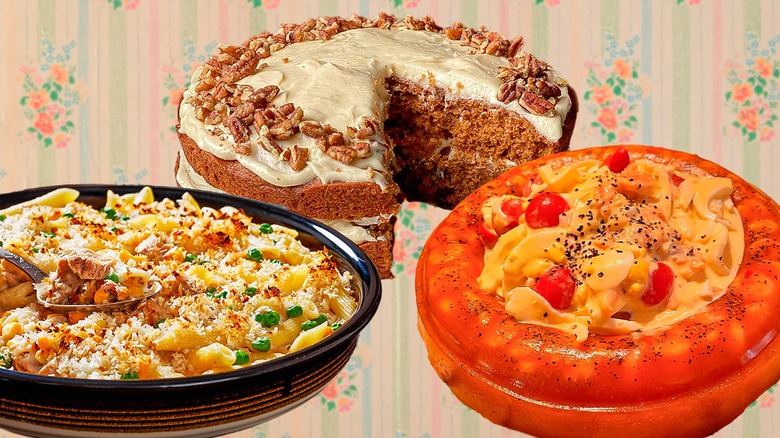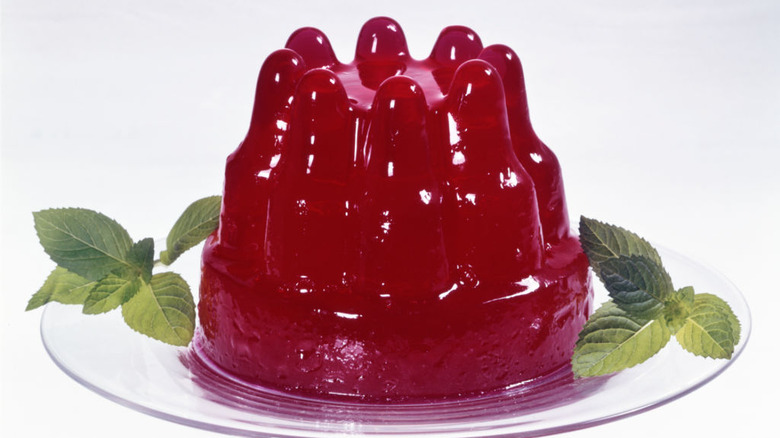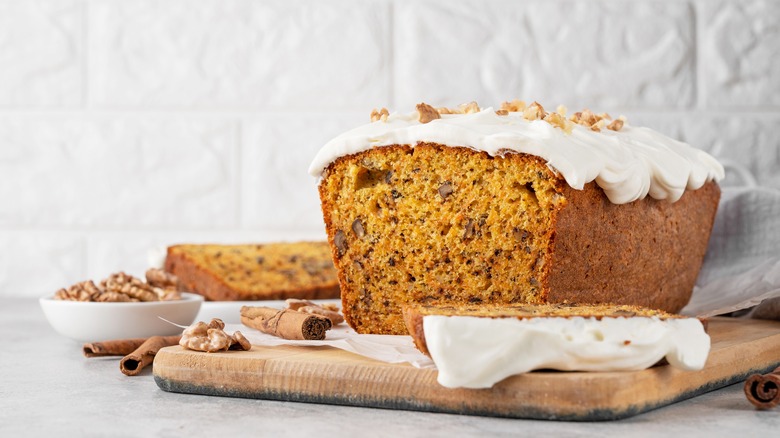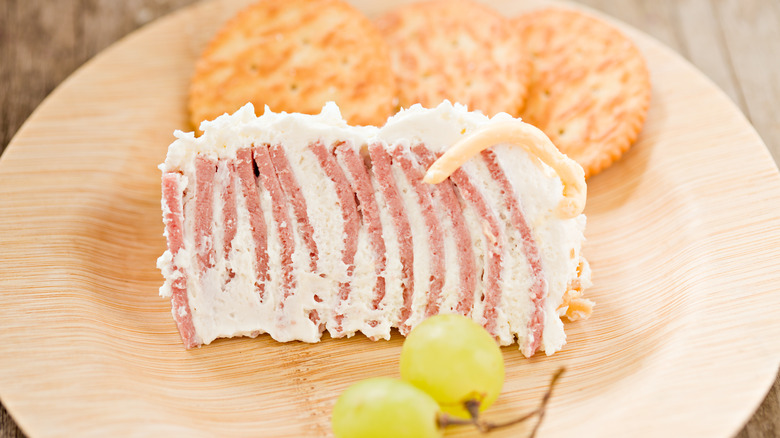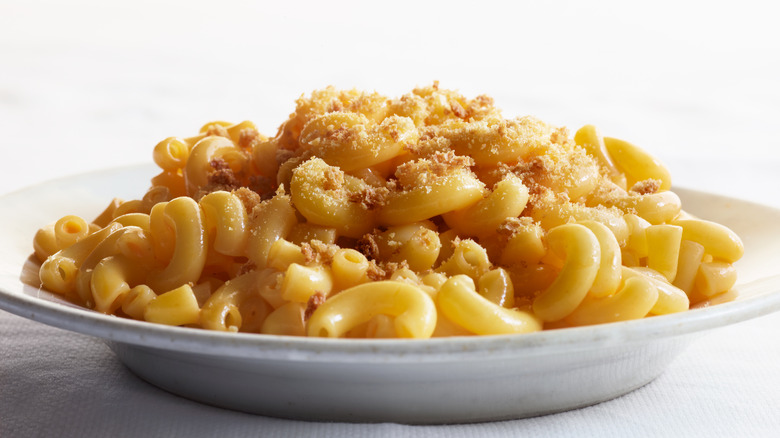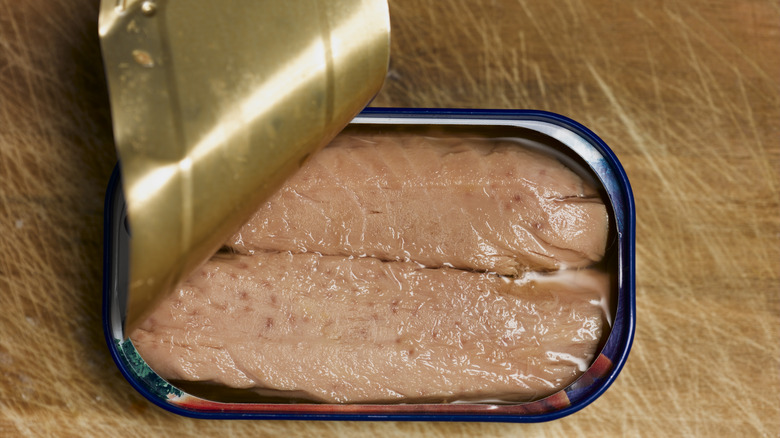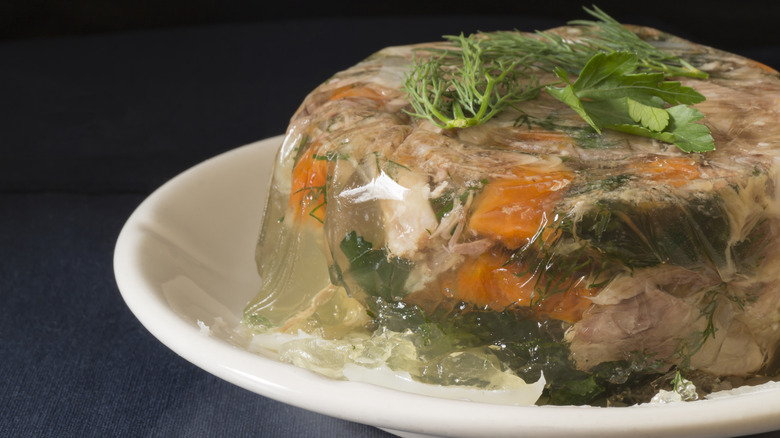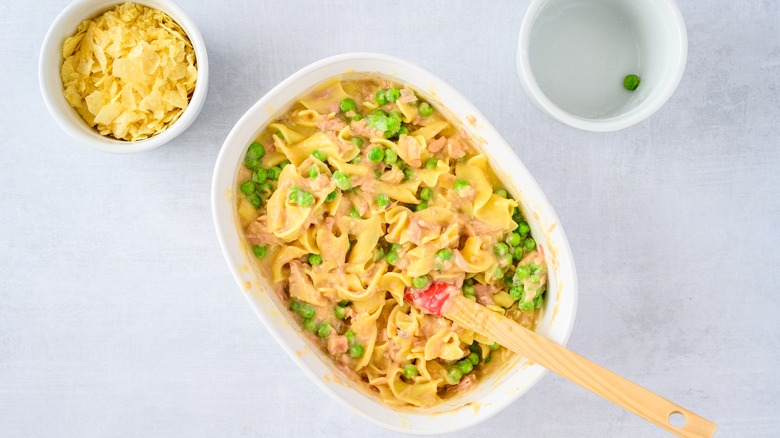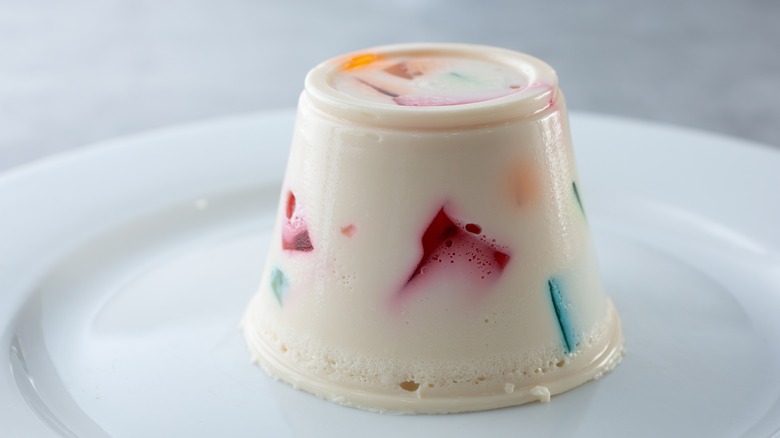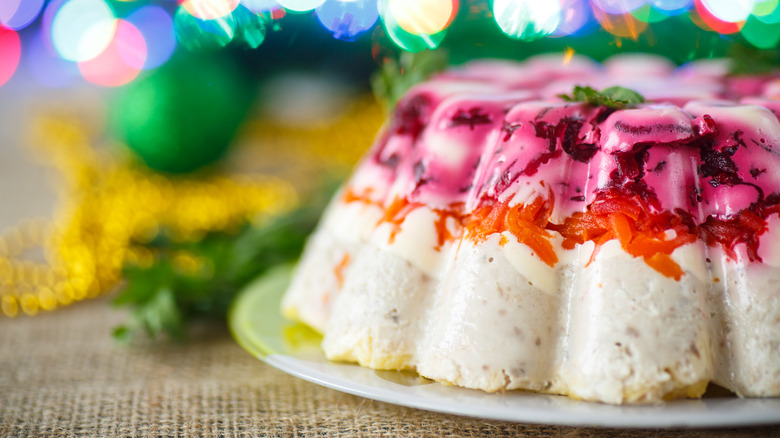11 Common Foods From The '50s That Aren't Around Anymore
The 1950s were an interesting culinary terrain. From Swanson TV dinners to savory gelatin salads, midcentury Americans crafted many dishes that seem almost alien to the modern palate. The '50s were a postwar landscape, and the packaged and canned food products of wartime America were here to stay. With thousands of American families moving to the suburbs and the advent of new culinary technology like the electric range, blender, and refrigerator/freezer combo, home cooks were in a luxury of convenience. Televisions played advertisements for products like Campbell's soup or Heinz pickles. Magazine ads and recipe cards displayed printed recipes using the advertised products. Supermarkets were stacked with gelatin powders, canned meats and veggies, and premade baking mixes.
For the '50s housewife, processed foods and an electric kitchen meant quick and efficient meals, with extra time and freedom for creativity. This resulted in experimental dishes with conventional ingredients coming together in incredibly unconventional ways. Foods like tomato aspic and macaroni loaf were once a common sight on American dining tables in the '50s, but they've been lost to history, and maybe it's for the best.
Tomato aspic
Aspic may not typically be found on your local restaurant menu today, but back in the 1950s, it was all the rage. Aspic is a savory jelly traditionally made by simmering animal bones to extract their natural gelatin. These savory gelatin dishes often had ingredients like meat or vegetables and have been consumed for centuries. Preparing food this way was originally an act of preservation when refrigeration wasn't available because the gelatin creates an airtight seal around the meat, limiting bacteria growth. If you've had soup dumplings, you've tried aspic because it is mixed into the meat as a solid and then turns into liquid broth as the dumplings steam.
In the late 19th century, when powdered gelatin packets began to be produced, aspics became a popular dinner staple. Visually pleasing with their bright colors and unique shapes, aspic dishes were a hit during an age where accessible ingredients and presentation were key. Home cooks often used packaged goods or leftovers from the night before and elevated them with unique gelatin molds, making aspics both affordable and visually intriguing. Tomato aspic was one of the classics of the '50s, made using canned tomato juice or tomato sauce along with onions and dried spices. Some chefs used lemon gelatin or even filled the center of the jelly mold with chicken salad.
Tomato soup cake
Cake made with tomato soup sounds bizarre, but it was a popular dessert for midcentury Americans. The cake — coined magic tomato soup cake — was created by Campbell Soup Company in the 1920s or '30s, with many reiterations of the recipe appearing in Campbell's cookbooks in the 1950s. The Campbell Soup Company was a household name during the '50s; it aired commercials on television, published advertisements with then-future president Ronald Reagan, and went public on the New York Stock Exchange. Its soups were staples in many households as both an ingredient and a meal of their own.
The key ingredient for tomato soup cake is a can of Campbell's condensed tomato soup. Recipes for this dessert have even been printed on the back of the soup can itself. Although it seems funky, the other ingredients are reminiscent of a classic carrot cake. With spices like cinnamon, cloves, and nutmeg and ingredients like flour, butter, baking soda, and sugar, the foundations of the cake are pretty typical. The tomato soup adds moisture and tanginess, which pairs well with the tanginess of the cream cheese frosting that tops it. The baking soda helps the cake to rise but also cuts the acidity of the tomatoes, limiting the prominence of the tomato flavor. The recipe also includes raisins, adding an extra layer of texture to the fluffy cake.
Spam Fiesta
Spam, a rectangular slab of pork, ham, salt, potato starch, sugar, and sodium nitrate, was — and still is — one of the most popular canned meats on the market. Originally branded as a luncheon meat, Spam became a household name following World War II, as it was served to Allied troops. Over 1 billion cans were sold by 1959. Products like Spam — processed and packaged foods — were popular during the 1950s, as supermarkets popped up nationwide, stocked with canned goods that could be easily and quickly turned into a meal. Spam was a popular ingredient choice, sometimes served fried with eggs, layered over a casserole, or diced into an aspic.
A popular recipe incorporating the lunch meat was called Spam Fiesta. A Spam Fiesta Cup, a recipe published in Family Circle magazine in 1956, combined Spam and peaches. The recipe included ground Spam mixed with oats, milk, ketchup, and mustard scooped into peach halves, and broiled. Another recipe published in 1955, called Spam 'n' Yam Fiesta Loaf, also had peaches. The recipe included canned sweet potatoes sandwiched between two thick slices of Spam and drizzled with peach juice and mustard. The spam was topped and surrounded by fresh peach slices.
Bologna cake
You may have heard bologna cake mentioned in the film "Sweet Home Alabama" and wondered if there is really such a thing. The answer is yes, but it's not what you think. Unlike tomato soup cake, which is an actual cake made with soup, bologna cake isn't actually a cake at all, at least not in the traditional sense. A typical bologna cake consisted of bologna layered slice by slice with cream cheese in between. The top layer was cream cheese acting as frosting and was often decorated using canned American cheese and green olives.
Some recipes opted to leave the sides exposed, showing layer after layer of meat and cheese, giving a ribbon-like visual effect. Others chose to frost the sides with cream cheese, adding decorations and garnishes, like a proper cake. Deli meats were popular in midcentury America due to the introduction of packaged and pre-sliced meats at supermarkets. Bologna was especially popular because it was cheaper than other deli meats like salami. Oscar Mayer, an American meat company, introduced vacuum-sealed packaging for deli meat, which prevented the meat from drying out too quickly. This made bologna a common ingredient choice for families around the country.
Macaroni loaf
A macaroni loaf is exactly how it sounds: macaroni and cheese molded in a loaf pan so that it maintains that classic loaf shape when removed. A recipe from 1956 uses elbow macaroni, Velveeta cheese, eggs, breadcrumbs, peppers, and onions. The ingredients themselves are similar to a modern-day macaroni and cheese recipe. Processed cheeses like Velveeta or Kraft singles were popular due to their longer shelf life, melting abilities, and mild flavor.
However, the cooking method for macaroni loaf is what really sets this dish apart from what we enjoy today. Once the cheese sauce is made, the ingredients are mixed together and poured into a loaf pan. The loaf is then baked in a pan of hot water. This is called a bain marie, a French term for hot water bath. Cooking the macaroni loaf in a bain marie allows the food to cook without direct heat contact. The hot water provides uniform, subtle heat, allowing even cooking throughout the dish. This method lets the macaroni keep its shape without getting too melty or too crispy throughout. A 1950s dish is nothing without presentation, so when the loaf is unmolded and placed on a serving dish, the recipe calls for tomato sauce and canned sliced mushrooms to be placed around it.
Baked fish loaf
Meatloaf is one of America's go-to comfort foods, and there have been many iterations over the years. Solidifying its spot on the American dinner table during the Depression, it served as a way to use leftovers and leave no food scraps to waste. By the 1950s, there were hundreds of meatloaf recipes out there, with the most common versions including ingredients like beef, breadcrumbs, and ketchup. But it wouldn't be a 1950s recipe without a twist. A recipe from Betty Crocker's picture cookbook, published in 1950, described a meal called baked fish loaf.
The recipe has a similar structure to a typical meatloaf, combining eggs, breadcrumbs, and protein into a loaf pan. However, rather than the typical beef or pork, the recipe opts to use drained and cooked salmon, tuna, or other fish. The fish loaf is baked in the oven for 35 to 45 minutes and garnished with a mushroom sauce. The final result is dense, like a meatloaf, and is served in thick-cut slices. An alternative topping that the recipe lists is sauteed pimento or green peppers.
Salad molds
Gelatin was one of the most fashionable ingredients in 1950s America, and gelatin salad was no exception. Jell-O salads could be found in magazines, cookbooks, and advertisements throughout the 1950s. Gelatin was so popular for savory salads that Jell-O released flavors like seasoned tomato, lime, mixed vegetable, and Italian, though the majority of these flavors have since been discontinued. Home cooks got experimental, finding new ways to elevate their gelatin. Some added mayonnaise or cream to the mix, making the gelatin look creamy instead of clear. Others used unique molds with fun shapes like fish for a fresh presentation. Usually, the gelatin would lay on a bed of lettuce or other garnishes.
In Betty Crocker's picture cookbook from 1950, there is a recipe for a seafood salad mold. The recipe used lemon-flavored gelatin, flaked fish or lobster, and celery. Other salad recipes paired chicken with almonds and cabbage with pickles. For these salads, the presentation was everything. The way the ingredients were layered into the mold allowed home cooks to show off their culinary and artistic skills. With an unblemished gelatin salad garnished with fresh herbs on the table, it was a surefire method to impress friends and neighbors.
Tuna casserole
The origin of the term "casserole" is Greek, from the word "kuathion" translating to "little cup," but its popularity reached new heights in midcentury America, as the dish fit all of the criteria that American cooks looked for during that period. Similar to meatloaf, casserole was a simple, filling, and nutritious meal that fed a family and made use of leftovers. This low-cost, convenient dish took America by storm, often using canned soups, veggies, and meats. It also left room for home cooks to get creative with the one-pot meal, as casseroles can be changed and adapted endlessly. Some casseroles are still staples today on holidays like Thanksgiving, where green bean casserole often makes an appearance on dining tables across the U.S., while others have faded out.
The most important aspect of a casserole is that it is cooked in a casserole dish and baked in the oven. Because of this, there are hundreds of different recipes that have emerged, some with ingredients that completely differ from others. Tuna casserole was incredibly popular in the 1950s. In a recipe from 1950 called Tuna Supreme, canned tuna is mixed with white sauce and olives and topped with cheese crackers. Another recipe included noodles, cream of mushroom soup, and a topping of crushed potato chips. Campbell's Soup Company had its own tuna casserole recipe, using its condensed cream of mushroom soup.
Crown Jell-O
It wouldn't be the 1950s without an endless supply of Jell-O dishes that have been lost in time to changing food trends. There were plenty of savory recipes, but also tons of colorful and flavorful dessert recipes, too! These dessert Jell-O dishes played with flavor, texture, and color. There was often layering of different types of gelatin, the addition of cream, and even Jell-O towers. Sometimes fruit was added in, like a fruit salad recipe from 1950 that included pineapples and cherries in lemon gelatin.
One showstopping Jell-O dessert from the 1950s was known as Crown Jell-O or Crown Jewel Jell-O. An advertisement from 1957 depicts Crown Jewel Jell-O with a ladyfinger crust and a glorious cross-section of multicolor Jell-O jewels in a pink, creamy gelatin base. The recipe uses raspberry, lime, and black cherry Jell-O that is set in advance and cut into cubes. The base gelatin is a mix of pineapple juice, strawberry Jell-O, and cream for an opaque coloration to contrast the translucent gelatin cubes. Some Crown Jewel Jell-O recipes have multiple tiers, and others have frosting or cream on the exterior. A few recipes opt to use only one type of gelatin for the cubes, while others use multiple. Either way, this dessert is definitely a visual showstopper.
Soufflé salad
Soufflé salads from the 1950s typically included gelatin and mayonnaise as a base. They were a popular side dish, with many recipes coming from canned or packaged food brands themselves. One example is Monterey Soufflé Salad from StarKist Tuna, which was the largest tuna canning firm in the world by the mid-'50s. Its recipe combined tuna with mayonnaise, lemon-flavored gelatin, celery, pimento peppers, and olives. A widely popular recipe from the period was the cranberry soufflé salad. Hellmann's Mayonnaise placed an advertisement for the recipe in a 1958 edition of Life magazine. This recipe was a classic for Thanksgiving and Christmas dinners, where a cranberry side is a must.
The cranberry soufflé salad is a combination of tart, tangy, and sweet. Canned cranberry sauce and canned crushed pineapples make up the fruit component. Lemon-flavored gelatin, Hellmann's mayonnaise, and lemon juice form the base. Tons of chopped celery are folded in, adding a crunch to each bite. Although the idea of a gelatin dish with a dinner meal seems a bit obscure, when it comes to cranberries, many of us are used to the gelatinous cranberry sauce that shimmies out of the can in perfect shape. Cranberry soufflé salad could be a viable side option for your next holiday dinner.
Frosted sandwich loaf
Midcentury Americans loved making dinner loaves, and sandwiches were not spared from that fate. The sandwich loaf, also called a sandwich cake, is neither a loaf, a sandwich, nor a cake. It is something that vaguely resembles all and yet is its own unique concoction. Sandwich loaves were typically made using a full loaf of sandwich bread, often with the crusts removed. The bread was then sliced lengthwise and layered with a variety of fillings — usually savory — and frosted with cream cheese. It was often served at parties since it didn't need to be heated and could be sliced to serve multiple guests. The fillings and garnishes varied from recipe to recipe, but individual recipes tended to use multiple types of fillings.
In a 1950 recipe for cheese sandwich loaf from Betty Crocker's picture cookbook, there are red, yellow, white, and green fillings. The red filling includes bacon and ham. The yellow is cooked egg yolks with salt and pepper. The white is cream cheese and cucumbers, and the green consists of pickles and watercress. The loaf is then frosted and garnished with sliced olives and toasted almonds. In a way, the sandwich loaf is a combination of many types of sandwiches stacked on top of one another and covered in cheese. Although not made today, it doesn't seem too far-fetched.
